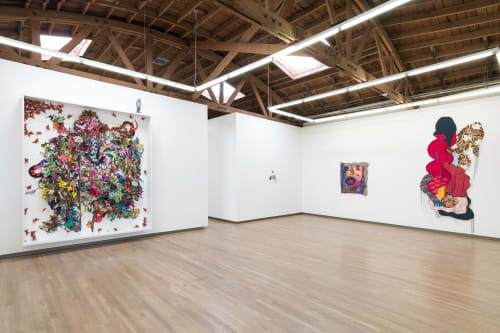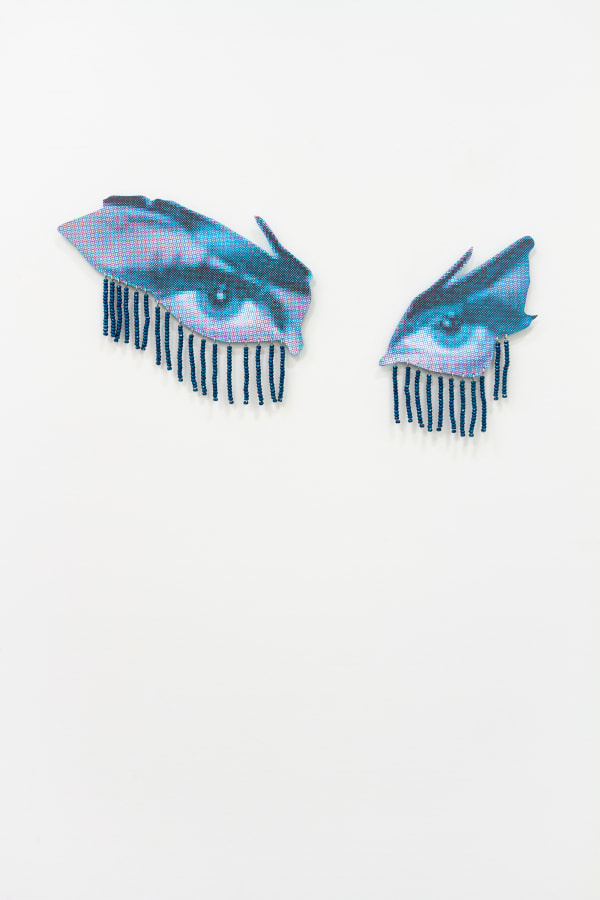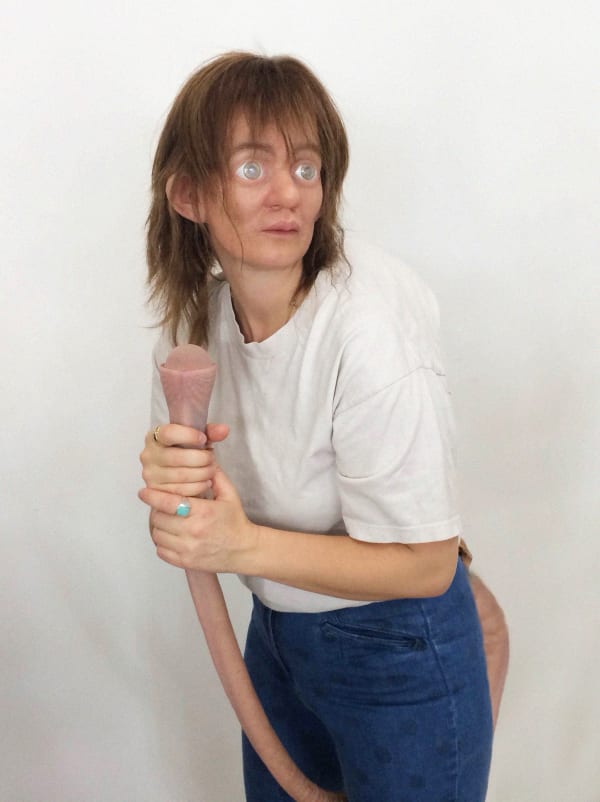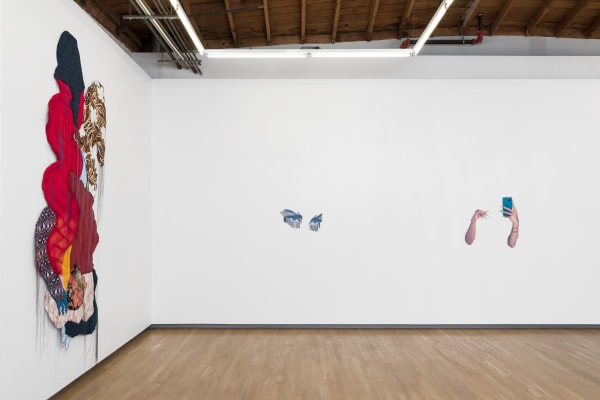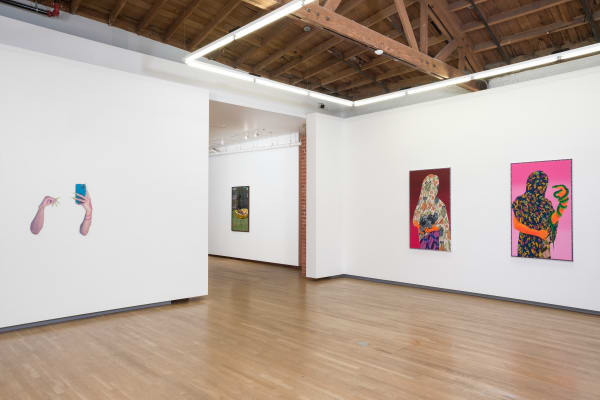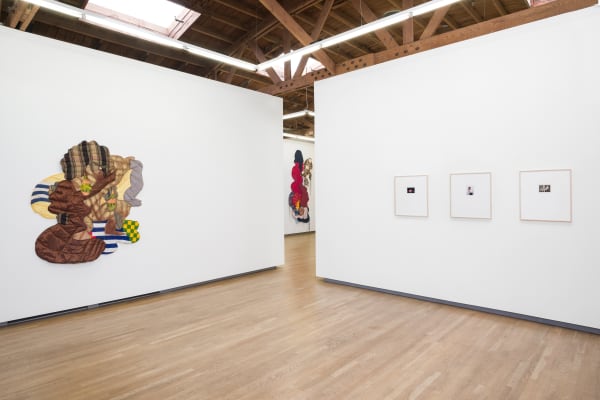Shulamit Nazarian is pleased to present Intersecting Selves, a group exhibition featuring Elliott Jerome Brown Jr., Maria A. Guzmán Capron, Amir H. Fallah, Wendell Gladstone, Julie Henson, Ellen Lesperance, Ebony G. Patterson, and Tori Wrånes.
Each of the artists in Intersecting Selves considers the body as a barrier between the mind and the outside world. Recognizing our competing desire for privacy and awareness, and the often thin boundary that intersects our public and private selves, these artists dictate what gets revealed, to whom, and on what terms. From the quietly personal to the urgently political, each artist engages with depictions of the body while withholding crucial information and context. In doing so, they maintain a position of power and restraint over the viewer and, simultaneously, beckon for a closer engagement.
The exhibiting artists of Intersecting Selves—which takes its name from one of Gladstone's paintings in the exhibition—evoke various strategies of representation. These artists utilize self-portraiture, employ avatars, and appropriate archival imagery to trouble the distance between the viewer and their subject. Bodies become draped in fabrics, lost in costume, and abstracted through the various mediums exhibited, including photography, collage, painting, and fibers.
Over the past decade, Wendell Gladstone has produced figurative paintings that evoke dream-like narratives, free from the logic that typically governs traditional representation. In his newest large-scale paintings, titled Cocoon and Intersecting Selves, Gladstone depicts a group of bodies: one peering through an interior window, one engaging with the outside world, and a third embedded into the architecture that separates the other two bodies. For Gladstone, each character represents various facets of an individual, perhaps a meditation on our inner and outer selves, or the mind and body. As with past works, the artist uses a bright, candy-colored palette. He layers with transparent mediums to subtly reveal the forms beneath, immediately seducing the viewer and only later revealing psychologically charged subtexts.
Elliott Jerome Brown Jr. positions his portrait practice within intimate spaces, often taking place in domestic settings such as the yard, front porch, or living room. Brown's portraiture favors a calculated distance between his subject and the viewer. Abstracted notions of the body figure more prominently than his subjects' faces, which are often obscured or excluded entirely. The tilting diagonals of the surrounding architecture further signal Brown's avoidance of an informative, frontal view. The obfuscation of his subjects challenges the traditional hierarchy held within photography, which for so long has privileged the viewer's ability to gaze versus the privacy of the subject. For Brown, the use of shadow, cropping, focus, and composition are all employed as tools that slow down the act of looking. The result is a more profound articulation of the interior or physiological space of his subject, as opposed to a portrait of their physical likeness.
Maria A. Guzmán Capron sews eclectic textiles together to construct embellished wall hangings that reveal peculiar subjects in expressive poses. Her cast of characters exhibits contrasting and exaggerated features, such as one hyper-muscular leg paired with a dainty arm. Often the features surreptitiously blend with their surroundings; other times, they aggressively leap forward. At first glance, the cacophony of color and pattern signal joy and vibrance, however upon closer inspection, the psychological qualities of the characters become more nuanced. Through her work, she creates a glimmer of a new reality: one where she embraces cultural hybridity, manifesting characters who constantly shape-shift, occupying a brief moment in which we can imagine a past and a future, articulated through material and form.
Made specifically for this exhibition, Amir H. Fallah has created two new paintings from his ongoing series of veil portraits that interrogate systems of representation in Western art history and the contemporary presentation of oneself. By veiling his subjects, his paintings question modes of portraiture while simultaneously using personal history as an entry point to discuss race, the body, and cultural memories. In Fallah's works, the absence of the sitter's likeness is substituted with a broader representation of their personhood—one that spans time and cultures and is articulated through a network of symbols and imagery. Fallah's paintings question the historical role of portraiture and the cultural systems used to identify one person from another.
Julie Henson explores the relationships between performer and audience, narrative and myth, and the connection between the stage and the retelling of parables. Having grown up in a religious family, her references generate from her early childhood experiences attending a hyper-performative megachurch, where stage lighting, fog machines, theatrical skits, and rock bands contribute to a collective religious experience. The wall-based sculptures in Intersecting Selves examine celebrity as a form of a contemporary idol and the digital sphere as a new space for worship, drawing equally from centuries-old methods of religious spectacle and the screen-based obsessions of today. Through this, she acknowledges the screen and stage as platforms to further understand our chosen idols, while also performing various versions of ourselves.
Through paintings on paper, rendered in gouache, Ellen Lesperance utilizes universal knitting vernacular to recreate historic garments worn by women activists, warriors, and cultural figures. For the past decade, she archived protest knitwear worn by the feminists of the Greenham Common Women's Peace Camp, a women's encampment that demonstrated against U.S. nuclear weapons storage in Berkshire, England (1981 to 2000). Lesperance is inspired by the protestors' creative direct-action tactics, including the use of sweaters with knit-in language and protest symbols. Her practice involves a close study of archival photographs, film, and video footage of these women-led protests. She then maps out and replicates their sweaters into two-dimensional abstracted patterns, which is an impulse to represent women in ways that evade the patriarchal legacy of figurative painting. In 2020, Lesperance published a book of this archive titled Velvet Fist. These abstracted forms and paintings become an homage and proxy for the brave activists.
Through a diverse practice in painting, sculpture and installation, Ebony G. Patterson focuses on the use of beauty as a tool to address global, social, and political injustices. For Intersecting Selves, Patterson has created a new monumental work that continues an exploration of the garden as a conceptual site. To construct the work, she tears and cuts paper by hand and then collages the work into densely intricate and sculptural forms, adding floral arrangements, insects, and birds to create a surface with high relief. As both a metaphor for colonial space and an extension of the body, Patterson believes these sculptural wall gardens become an active site of power. Through these strategies, Patterson entices the viewer to look more deeply, confronting the gaze with both beauty and horror. "Beauty, for me, is a tool of seduction," Patterson says, "a trap." Bodies appear present, albeit hidden and buried in the overgrown garden landscape. Through her work, she memorializes bodies that have been historically overlooked.
Tori Wrånes is known for her ambitious and surreal performances involving sound, prosthetics and make-up, props, kinetic sculpture, architecture, and multiple choreographed performers. She explores myths and folklore through dreamlike narratives. Presented in Intersecting Selves is a series of photographs that is based on her past performances featuring various characters and avatars. These photographs are paired with new audio work—structured as a call and response—that scatter voices and song throughout the gallery. Wrånes has developed a unique method of communication coined as "troll language." Using sound to convey primal emotions and truths, the artist bypasses the structural hierarchies of language and rational thought. For Wrånes, the troll is a metaphor for the id and human fate alike; it represents our hidden truths. The result is a wide-ranging, experimental, and ritualistic practice that freely draws on ancient stories and contemporary struggles to speak to the human experience of past and present.
Elliott Jerome Brown Jr. (b. 1993, Baldwin, NY; Lives and works in Brooklyn, NY) has been featured in exhibitions domestically and internationally. Brown Jr. was a participant in the Skowhegan School of Painting and Sculpture in 2017 and in the New York Times Portfolio Review 2016. He received his BFA in Photography from the Tisch School of the Arts, New York University. His work has recently been exhibited in Any distance between us, RISD Museum of Art, Providence, RI; New Photography: Create, Collect, Compile, New Orleans Museum of Art; A Language for Intimacy, Abrons Arts Centre and Boston Center for the Arts; On Refusal: Representation and Resistance in Contemporary American Art, The MAC, Belfast, Ireland; and has been the subject of a solo exhibition at Nicelle Beauchene Gallery, New York, NY.
Maria A. Guzmán Capron (b. 1982, Milan, Italy; Lives and works in Oakland, CA) was born to Colombian and Peruvian parents and received her MFA from California College of the Arts in 2015 and her BFA from the University of Houston in 2004. Solo exhibitions include Texas State Galleries, San Marcos, TX; Premier Junior, San Francisco, CA; Roll Up Project, Oakland, CA; and Guerrero Gallery San Francisco, CA. Select group exhibitions include pt.2 Gallery, Oakland, CA; NIAD Art Center, Richmond, CA; CULT Aimee Friberg Exhibitions, San Francisco, CA; Buffalo Institute for Contemporary Art, Buffalo, NY; Deli Gallery in Brooklyn, NY; and Mana Contemporary in Chicago, IL. Her works have been written about in Variable West, Bomb Magazine, and Art in America.
Amir H. Fallah (b. 1979 Tehran, Iran; Lives and works in Los Angeles) has exhibited extensively across the United States and abroad. Selected solo exhibitions include the Museum of Contemporary Art in Tucson; South Dakota Art Museum, Brookings, SD; Schneider Museum of Art, Ashland, OR; San Diego Art Institute; ICA San Jose; and the Nerman Museum of Contemporary Art, Overland, KS. His work is in the permanent collection of the Jorge M. Pérez Collection, Miami; McEvoy Foundation For The Arts, San Francisco; SMART Museum of Art at the University of Chicago; Davis Museum, Massachusetts; The Microsoft Collection, Washington; Plattsburgh State Art Museum, NY; Cerritos College Public Art Collection, CA; and Salsali Private Museum, Dubai, UAE; Museum Of Art and History, Lancaster, CA; Van Every/Smith Galleries, Davidson College, NC. Fallah received his BFA in Fine Art & Painting at the Maryland Institute College of Art and his MFA in Painting at the University of California, Los Angeles. He is represented by Shulamit Nazarian.
Wendell Gladstone (b. 1972, Boston; Lives and works in Los Angeles) received his BA at Brown University, an MFA in Painting at Claremont Graduate University, and attended the Skowhegan School of Painting and Sculpture. He has exhibited in numerous solo exhibitions, including at Shulamit Nazarian, Los Angeles; Kravets/Wehby, New York; Roberts & Tilton, Los Angeles; and the San Diego Museum of Contemporary Art. Select museum group exhibitions include the Hammer Museum, Los Angeles; Torrance Art Museum, Torrance, CA; Las Vegas Art Museum, and the Chelsea Art Museum, New York. He is represented by Shulamit Nazarian.
Julie Henson (b. 1983 Charleston, SC; Lives and works Los Angeles, CA) received her MFA from California College of the Arts in 2011. Henson has had solo exhibitions at Anat Ebgi, Los Angeles; the Columbia Museum of Art, South Carolina; Yes Ma'am Projects, Denver; and SPRING/BREAK Art Show with the Buffalo Institute of Contemporary Art, NY. She has also participated in group shows at numerous museums and spaces including the Ben Maltz Gallery at Otis College of Art, Los Angeles; the Torrance Art Museum, Torrance; and the Visual Art Center at the University of Texas, Austin. Henson's work has been reviewed in Elephant Magazine, Artforum, and Hyperallergic and she was a 2017 nominee for the Rema Hort Mann Foundation Emerging Artist Award.
Ellen Lesperance (b.1971, Minneapolis, MN; Lives and works in Portland, OR) lives and works in Portland, USA. She has exhibited widely in the United States and internationally. Solo exhibitions of her work have been presented at Derek Eller Gallery, NY; Baltimore Art Museum; Portland Art Museum; Galerie Anne de Villepoix, Paris, FR; and Seattle Art Museum. She has participated in significant group exhibitions internationally, most recently at the Tang Teaching Museum, Saratoga Springs, NY; Institute of Contemporary Art, Boston; Frye Museum, Seattle; Museum of Art São Paulo, Brazil; Nottingham Contemporary and De La Warr Pavilion, United Kingdom); Honolulu Biennial; Brooklyn Museum; Tate St. Ives, UK; and The New Museum, NY.
Ebony G. Patterson (b. 1981 in Kingston, Jamaica; Lives and works in Kingston and Chicago, IL) received her BFA from Edna Manley College, Kingston, Jamaica in 2004 and MFA from Sam Fox School of Design & Visual Arts, Washington University, St. Louis in 2006. Patterson's solo exhibitions and projects include the Baltimore Museum of Art; The Studio Museum in Harlem; Atlanta Center for Contemporary Art; and SCAD Museum of Art Savannah, GA. Her work was included in Open Spaces Kansas City, MO; the 32nd Bienal de São Paulo; the 12th Havana Biennial; Prospect.3: Notes for Now, New Orleans, and the Jamaica Biennial. Patterson's works are included in a number of public collections, including the Whitney Museum of American Art; Virginia Museum of Fine Arts; Brooklyn Museum; The Studio Museum in Harlem; and the National Gallery of Jamaica. Her first major survey exhibition …while the dew is still on the roses… opened at Pérez Art Museum Miami in 2018; then toured to Speed Art Museum in Louisville, KY; the Nasher Museum Durham, NC; the Contemporary Art Museum, St. Louis; Kunsthal Aarhus, Denmark, and the ICA San Jose. It will be included in the upcoming Athens and Liverpool Biennials in 2021.
Tori Wrånes (b. 1978 in Kristiansand, Norway; Lives and works Oslo, Norway) Her recent solo shows include Handmade Acoustics at Ujazdowski Castle for Contemporary Art in Warszawa; Hot Pocket at Museum of Contemporary Art, Oslo; Ældgammel Baby / Ancient Baby, Kunsthal Charlottenborg Denmark; Flute Warriors, with Red Comunitaria Trans, Bogotà, Colombia; and Drastic Pants, Carl Freedman Gallery London. Select performances include Stone and Singer commissioned by the 19Th Biennale of Sydney; Yes Nix, commissioned by Performa 13, New York; Colombo Art Biennale, Sri Lanka; Dhaka Art Seminars, Bangladesh; CCA Lagos, Nigeria; The Eccentrics, Sculpture Center, New York. Recently commissioned work includes Naam Yai, for Thailand Biennale in Krabi. She is represented by Shulamit Nazarian.
-
 Elliott Jerome Brown Jr.The tire grits its teeth along the gravel and brakes to silence - a pause for effect. / Have you ever siphoned rupture through a narrow opening? / (Do you know the control it takes to slingshot a sound?), 2019Archival inkjet print51 x 34 inchesEdition 1 of 5, 2 APs
Elliott Jerome Brown Jr.The tire grits its teeth along the gravel and brakes to silence - a pause for effect. / Have you ever siphoned rupture through a narrow opening? / (Do you know the control it takes to slingshot a sound?), 2019Archival inkjet print51 x 34 inchesEdition 1 of 5, 2 APs -
 Ellen LesperanceThe Pink and the Black Triangle, 2020Gouache and graphite on tea stained paper, wool sweater hand-knit by the artistDrawing 22 x 29.5 inches
Ellen LesperanceThe Pink and the Black Triangle, 2020Gouache and graphite on tea stained paper, wool sweater hand-knit by the artistDrawing 22 x 29.5 inches
Sweater Dimensions Variable -
 Amir H. FallahLife, 2021Acrylic on Canvas60 x 36 inches
Amir H. FallahLife, 2021Acrylic on Canvas60 x 36 inches -
 Ebony G. Patterson...for souls...for soles...between the cuts, beneath the leaves, below the soil.., 2021Work on paper107 x 97.5 x 14 inches
Ebony G. Patterson...for souls...for soles...between the cuts, beneath the leaves, below the soil.., 2021Work on paper107 x 97.5 x 14 inches -
 Julie HensonBetween Reality and Theater, 2021Pigment print on aluminum, beaded fringe12.5 x 24.5 in
Julie HensonBetween Reality and Theater, 2021Pigment print on aluminum, beaded fringe12.5 x 24.5 in
31.8 x 62.2 cm -
 Maria Guzmán Capron, Cuídame, 2021
Maria Guzmán Capron, Cuídame, 2021 -
 Tori WrånesThe Singer, 2021PhotographImage: 4.6 x 3.5 inches
Tori WrånesThe Singer, 2021PhotographImage: 4.6 x 3.5 inches
Framed: 23.8 x 18.7 inchesEdition of 10 plus 2 artist's proofs -
 Wendell GladstoneIntersecting Selves, 2021Acrylic on canvas80 x 66 inches
Wendell GladstoneIntersecting Selves, 2021Acrylic on canvas80 x 66 inches
